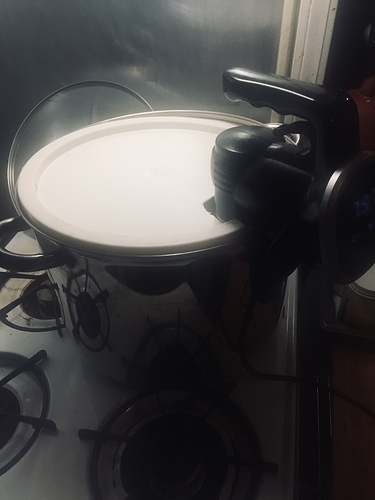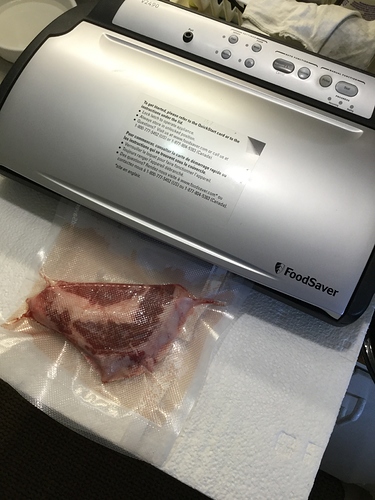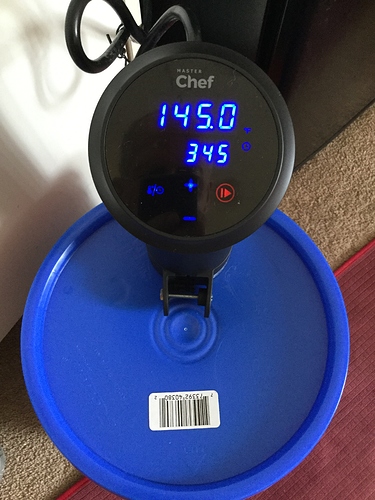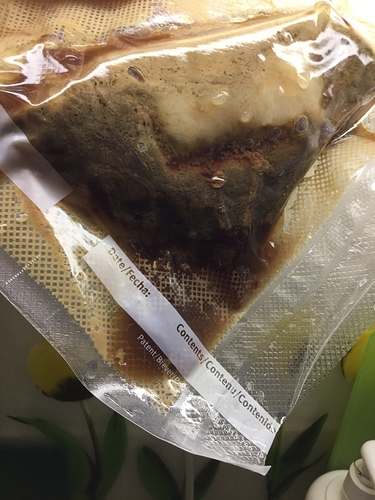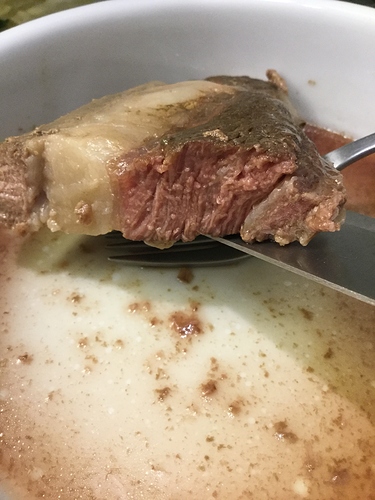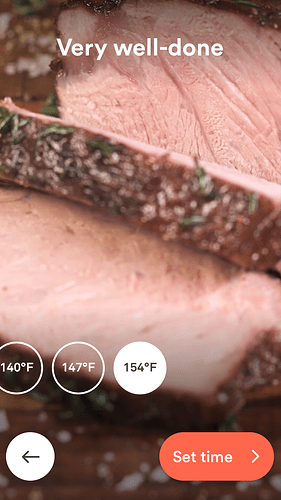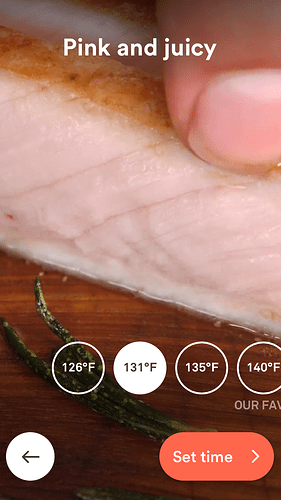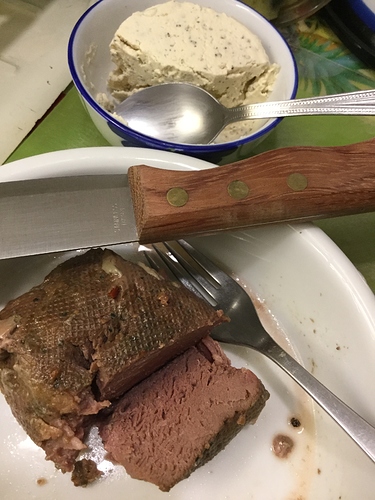What is unique about sous vide? From what I’ve learned so far, it’s not the slow cooking because other methods utilize slow cooking. It’s not low temps because other methods utilize low temps. It’s not even the water bath because if you ever hard boiled or poached an egg you utilized a water bath. No, what’s truly unique about sous vide is just what its name says: under vacuum. It’s the vacuum sealing to remove as much air as possible that makes sous vide unique.
Mike's Excellent Sous Vide Adventure 🥩
I understand that sous vide means “under vacuum”. However, I have never vacuum packed my stuff. The true value that cooking sous vide delivers for me is that the controller can maintain the temperature so precisely for an indefinite period, and that the water can transfer heat to the item being cooked uniformly.
Nice and welcome to the wild world of sous vide!
What do you have planned for your first few cooks?
I dunno’ Michael. NO other method offers such precision control of temps. A Crock Pot is not even close to the same thing. You have to add water (dilute) your recipe, just to keep everything under liquids.
Poaching an egg is a different thing, as the shell keeps everything inside, with no diluting of the egg.
I know there are some guys who think that vacuum sealing with a machine is important, but honestly, I just don’t see it. There is no way you could make meat any more tender (heck, I can turn it into mush if I wanted to… or should I say, by accident) or any more juicy… I’ve actually made beef that I wish was just a touch drier, as it would not even soak up any Au Jus sauce…
Now, I do kind of pride myself at using a straw to vacuum my freezer Ziplocs quite well. Not as super vacuumed as a machine would do, I’m sure. But certainly 95+% as well. Put it this way, my bags never try to float.
In fact, I keep straws around, and even when putting away leftovers and such, I always vacuum my Ziplocs… Have to be careful with my Keto bread though, as I can easily crush it into a wad  lol
lol
@Jamboribs Steve, unfortunately I just finished day 3 of 7 consecutive so not conducive to learning exactly how to use my new cooker. I have some of this still frozen. I might take a piece out of the freezer tomorrow evening to let it thaw overnight in the fridge. Then I could bag and start to cook it after I get home from work around 1pm Sunday for supper.
@FishChris Chris, a lot of folks seem to agree with you about the vacuum. But my feeling is the French didn’t name it ‘under vacuum’ for nothing much. Since I already have the vacuum bagger and know how to use the thing, I’m going to try it. I do know how to get the air out of a Ziplock bag, although I didn’t use your straw method which I bet probably works better than simply letting water compress the bag. I have plenty of Ziplocks so the next time I use one I’ll try the straw method. I think that would be way safer with a very wet piece of meat rather than the vacuum bagger. Don’t want to suck any liquid into it!
Also, I think you’re right about temperature control. I think it’s much easier to control the temp of a water bath than circulating air, for example. Even so, I still think the vacuum is what makes sous vide unique. And ‘vacuum’ does not necessitate a machine. If the object of the exercise is simply to remove as much air as possible so the meat is exposed uniformly to the water bath, a machine will do a better job, but your straw method is adequate as is simply letting the water bath force out the air. I think it’s probably more important to make sure no wrinkles form in the bag directly over the meat.
…and you know Michael, you could actually submerge your Ziploc with meat, bottom first, AND use the straw method at the same time, and that might work better yet.
But anyway, the way I see it, there are really only three parameters to consider when cooking SV… 1) how well done 2) how tender and 3) how evenly cooked…
And so if you can nail all 3 of these things consistently (which I am starting to now) using Ziplocs, I just can’t see any advantage to vacuum sealing.
Like I say, at this point, I’m starting to play around with different marinades and seasonings, because I have most of my meats completely dialed in for doneness and tenderness. and so on that front, results might still vary 
First test run tonight with empty bucket of water. It was pretty easy to set the temp and time. I only set the temp to 130℉ but I can smell the plastic bucket. Hopefully, it will degas and that will be the end of it. Not overwhelming or anything, just noticeable.
Nice touch, the timer didn’t start until the water reached 130. Took about 15 minutes to get there.
Nice AAA Angus rib steaks. If you like a medium steak try a sprinkle of salt & pepper, sous vide at 134* for 1 1/2 - 2 hours. You can simply eat it when it is finished or give it a quick sear to add some colour. Sous vide is very forgiving. I am a huge fan of the Foodsaver vacuum bags so that is how I seal my meats. I ruined a nice piece of meat once using the Ziploc bag method, never again.
Enjoy!
Posting this for reference:
I used the same technique and still do if I take my pod on vacation to visit people. It’s close enough to vacuum but a food vac has advantages.
Here’s my setup Michael
It’s a 16 qt stock pot with a bucket lid that fits perfectly in the rim. I like using a metal pot because I can preheat the water on the burner to get cooking fast. I have a couple smaller vessels that I can do a steak or a few chicken thighs in about a gallon of water. 
2019-10-06 Today’s endeavour:
Note, I did what I could call a ‘soft vacuum’. I vacuumed the bag until the meat was compressed somewhat, then stopped vacuuming for a couple seconds before sealing. This allowed a small amount of air back into the bag. Notice liquid from the meat has migrated into the air channels of the bag. This is a FoodSaver bag.
145℉ for 4.0 hours, 15 minutes in.
Looks like about a 1/4 - 1/2 teaspoon of liquid in the bag. This was a very moist piece of meat with about 50% fat, so not much left the meat. Next time I’ll try what I could call a ‘hard vacuum’ to see if it loses any less liquid.
The payoff! Note the fat is translucent/opaque and was quite easy to chew, although slightly tougher than the meat itself. Overall not a bad first attempt. I think next time I’ll go for 150℉.
Sous vide?
Sous vide?
Considering a Sous Vide machine
David, that’s a nice set up. I am also attracted to using a metal pail in order to be able to preheat on the stove. I went with the plastic bucket mostly because I didn’t want to wait until I got around to making a hole in a metal lid. Although, if I could locate a bucket/pot with the correct diameter I could use the plastic lid like you. Thanks.
Good idea! I also thought that next time I’ll put a strip of paper towel above the meat in an attempt to minimize migration of liquid towards the open end of the bag during vacuuming.
I wouldn’t sousvide with a paper towel inside. I use generic cut to size bags. I bought these about two years ago and I am working on the last rolls. They are great quality and much cheaper than real food saver bags.
2 Pack - 11" x 50’ Vacuum Sealer Rolls Food Storage Saver Commercial Grade Bag for Foodsaver and Sous Vide (total 100 feet) https://www.amazon.com/dp/B01K07MZBO/ref=cm
SALE! Two 8"X50’ Rolls of FoodVacBags 4 mil Commercial Grade Vacuum Sealer Bags - Make Your Own Size Bag! - for Foodsaver, Seal-A-Meal, plus other machines https://www.amazon.com/dp/B00CPS32MI/ref=cm_sw_r_cp_api_i_XGQMDb20ZQ59R

What’s your objection to paper towel in the bag? Do you think it would add something undesirable? Turn to indistinguishable mush?
You know it just occurred to me. My FoodSaver has a tube attachment designed to vacuum special containers. I wonder if I could use that to vacuum a Ziplock bag like Chris’s straw method. Maybe less migration of liquid up the bag because it’s not channeled. Less chance of sucking liquid into the machine.
Maybe? I just haven’t ever found anything like that necessary. I would be worried about any chemicals in the paper like dioxins maybe? Formaldehyde? Bleach?
Also I use the juice generally. Pan sauce, or I keep a container in the freezer and dump it in. When it gets full I cook it down and make a Demi glacé type liquid for cooking with. Or add some to stuff like green beans as a braiding liquid. It also adds to soups.
I have a rig that plugs on the end of that hose, it vacuum seals reg and wide mouth mason jars. Great for extended refrigeration of stuff like marinara or bone broth to keep about 3x as long under refrigeration without going bad. You can make creme brûlée’s or custard in 8oz mason jars too. I have made imitation egg bites (Starbucks food item) that are pretty good. You can make a bunch for easy breakfasts.
https://anovaculinary.com/easy-homemade-sous-vide-egg-bites/
I highly recommend downloading the free Joule app as a guide for sousvide times and temperatures. It’s the best and has great mini videos showing each level of meat from rare to well done and frozen & fresh cooking times for meats. I start most of my stuff from frozen. I buy a big piece of meat, cut it into portions, salt, vacuum and freeze. When you want to cook just pull it from the freezer and toss it in the bath. 
At 150F the steak will be extra well done and quite tough without an extended cook time. I missed what cut that was you used. Stuff like chuck will need a longer cook than a ribeye or sirloin.
If you want it pink but more tender use a longer cook time and keep the temperature low. Definitely download the Joule app, you will learn from it to zero in on your favorite temperatures and times. Sousvide will hold meat for quite a while without overcooking it so you can experiment with cook times to get the texture you want. I cook beef as low as I can get away with it. If you sear it will cook a little more so I undercook the temperature but stay at 130F minimum for myself. The longer cooking time will be rare but completely pasteurized. I do pork loin or tenderloin pink all the time, like 132F. I like to Blacken them afterwards Cajun style. Super juicy and tender. Video still of pork loin chop from the Joule app,

Again one of these at 140℉ for 6 hours. I wanted to see if the additional time would have a noticeable effect on the meat’s tenderness. And it did!
That’s a bowl of Boursin Cracked Black Pepper Cheese behind. The meat has so little fat I had to add something to bump up the overall fat for the meal. Boursin is a high fat cheese, creamy in texture with a mild flavour. This was the first time I tried it. Like it a lot!

